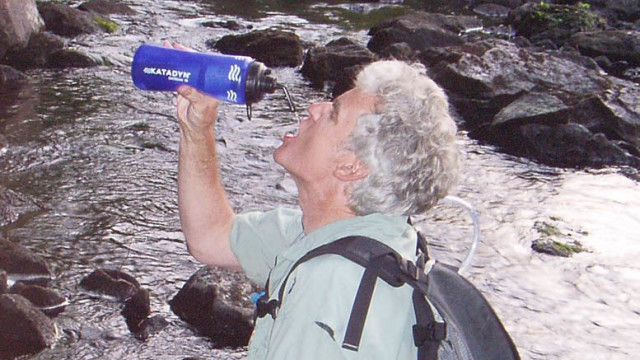“Water, water, every where, Nor any drop to drink.”

When Coleridge wrote this usually-misquoted line in his The Rime of the Ancient Mariner in 1798, he was talking about a ship adrift on the sea. But he might as well have been have been speaking to active outdoors people afield here in the northeast.
Clean drinking water is an absolute necessity when you’re active outdoors. Unfortunately, places where you can just drink the water from a stream or pond are a rarity.
Water-borne baddies like Giardia and Crytosporidium and various bacteria including E-coli hadn’t even been discovered in 1798. People just drank water. Those with healthy immune systems drank water and stayed healthy; others got sick and sometimes died. Today we not only have a greater understanding of how you can get sick from drinking unclean water, we also have better means than ever of dealing with the threat.

Stay Hydrated: Warm Weather sand Cold!
Staying fully hydrated helps prevent heat exhaustion and heat stroke. Drinking lots of water is the first item on any list of how to stay cool in the heat of summer. It may even help prevent accidents. I don’t have any hard evidence to support this, but I also believe that dehydration can lead to fuzzy thinking. I’ve often wondered how many outdoor incidents — hikers getting lost or hurt, bikers taking falls, happened because the hiker or biker was dehydrated and not thinking clearly.
In colder weather, dehydration can be deadly. Cold air dehydrates you quickly. and dehydration makes it difficult for your body to stay warm. Try taking a drink of water the next time you find yourself shivering. That’s often all you need to warm up.
Stay Hydrated: Carry Or Treat The Water You Need
Once you wander away from the water tap, you have two strategies for supplying clean water for drinking, cooking and clean-up: Pack it in, or treat a local source.
The main problem with bringing what you need is that water is very heavy — 8.3 pounds a gallon. And you can and should drink a lot to stay hydrated when you’re outdoors.
Packing your own water is the primary strategy for most one-day adventures and even overnight camping with uncertain water sources. Many springs and small brooks simply dry up during prime camping season in the late summer and fall.
How much water do you need? I’ll commonly carry two liters on a short hike, four liters for a full day and six to eight liters for an overnight. Four liters is just under a gallon so the weight adds up quickly. Eight liters of water weighs more than my tent, sleeping bag, pads, stove and cook kit for a summer overnight. I find the new hydration systems which use a lightweight bladder and a drinking tube much more efficient and convenient than water bottles.
If there are reliable springs, streams and ponds on your route, carrying lots of water it isn’t necessary. On longer hikes, hauling all the water you need isn’t an option. Lightweight filtration systems, available at any camping shop, easily clean enough water for personal use. Some will deliver enough clean water for a small group. Just be sure to replace the filter units as often as the manufacturer recommends. A clogged filter can prevent any water getting through and leave you very thirsty .
Stay Hydrated: Water Packing Options
Packing water used to be much harder when the only available vessels were glass bottles, metal canteens, and rubber water bags. Today, we have a host of options.
A lot of outdoor folks use the plastic bottles that you buy water in at the supermarket. These are lightweight, cheap, and available everywhere. However, there have been some questions raised about the safety of re-using them due to the BPS content of the plastic released as the plastic degrades over time. And some idiots apparently think that, because they are disposable, they can be thrown away along the trail.
Reusable bottles are sturdier, easier to keep clean, and have tops that don’t get lost. The wide-mouth bottles from Nalgene are pretty much the gold standard.
Hydration systems come as a hydration pack or as a bladder-and-drinking-tube combo that can ride in a standard pack. Check out Platypus), Hydrapak, Camelbak, Mountainsmith and Nalgene for examples. The bladders alone or in a cloth protective sleeve make great storage containers for the trail.
Several companies make filtration systems for outdoor use. Filters are generally quicker and more convenient for purifying water than chemical treatments, which often take a long time to work and taste bad.
McNett makes a filter straw called the Frontier, which lets you sip directly from an untreated water source. It is described by the company as an emergency filter.
A Katadyn water bottle with a built-in filter system is a great backup on day hikes. You can drink from it or use it to re-fill a water bladder. For overnight or longer trips, their Hiker pump filter, which handles a lot of water fast.
First Need also makes portable water purifiers.


